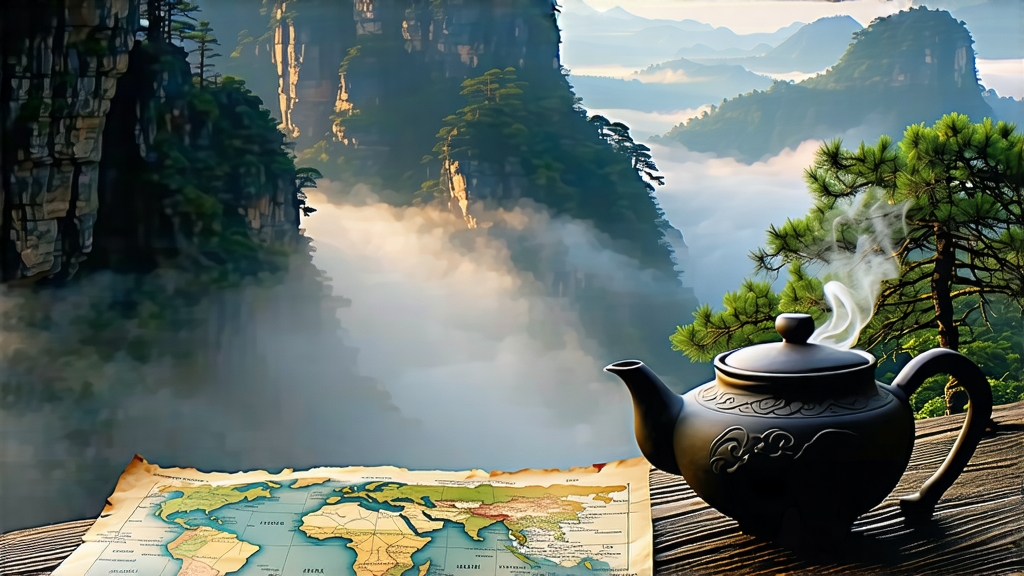
Ask most tea lovers to name the first black tea ever created and they will pause; mention Lapsang Souchong and the same faces light up with recognition. Hailing from the granite gorges of the Wuyi Mountains in China’s Fujian province, this legendary leaf is simultaneously the progenitor of all black teas and one of the most polarizing cups on Earth—its fragrance of pine smoke and longan can transport drinkers to a campfire in the forest or send them fleeing for a “cleaner” brew. To understand why, we must travel nearly four centuries back to a time when green tea was the only tea China knew, and accident, geography and human ingenuity conspired to turn verdant leaves obsidian.
History: From Green to Black in One Sleepless Night
Legend places the birth of Lapsang Souchong around 1568 in the village of Tongmu, a narrow settlement wedged between the Wuyi Nature Reserve and a forest of Masson pines. Qing-era annals record that passing armies disrupted the spring harvest; fresh leaves withered overnight on bamboo mats while villagers fled. By dawn the jade-green leaf had reddened, and in desperation the farmers rushed the crop to market over smoking pine fires to mask any off-aromas. Foreign traders—first Portuguese, later Dutch and English—found the dark, glossy leaf intoxicating, its liquor malty yet kissed with resinous sweetness. They christened it “bohea” (from the local “Wuyi”) and shipped it down the Min River to Canton, where clipper boats carried it to London coffee-houses. Within decades bohea fetched prices higher than silver, funded the East India Company, and inspired the British to plant tea gardens half a world away in Assam and Ceylon. Thus every modern black tea traces its lineage to that Tongmu accident.
Terroir: Why Only Tongmu Tastes Like Tongmu
The Wuyi range is a UNESCO biosphere whose cool, humid microclimate is carved by mist rising from nine twisting streams. Day-night temperature swings of 15 °C slow leaf growth, concentrating sugars, amino acids and volatile aromatics. Soils are a jumble of weathered granite and red sandstone, poor in nitrogen yet rich in potassium and trace minerals that give Wuyi teas their trademark “rock rhyme” (yan yun)—a lingering mineral finish that echoes like struck stone. Crucially, Tongmu lies inside a national park where outside plant material, pesticides and even gasoline vehicles are banned; only indigenous tea cultivars such as Xiao Zhong (small-leaf) or Cai Cha (mixed-leaf) survive, many over 150 years old. These old bushes send roots deep into fissures, sipping spring water filtered through pine litter, an underground marriage that pre-loads the leaf with terpenes destined to bond with pine smoke later in the process.
Craft: The Eight Stages of Smoke and Fire
Although modern factories elsewhere mimic the style with generator-driven smoke, true Tongmu Lapsang is still hand-made in eight painstaking steps, each timed by senses sharpened since childhood.
- Plucking: Only the first two leaves and a bud are taken before Grain Rain, when amino acids peak and tannins remain gentle.
- Solar Withering: Leaves are laid on water-reed mats in weak spring sun for 30–40 minutes, softening cell walls without bruising.
- Indoor Withering: Baskets move to the upper floor of a three-hundred-year-old wooden house where mountain breezes finish the job over 4–6 hours; the leaf loses 60 % moisture and emits a faint cucumber aroma.
- Rolling: A barefoot worker treads in a bamboo drum, breaking cell walls just enough to release enzymes while keeping the strip intact.
- Oxidation: The mass is piled in pine-wood trays inside a stone-walled room kept at 24 °C and 80 % humidity. For three hours the leaf reddens from edge to center, developing theaflavins that will later balance smoke.
- Pan-firing: A quick 200 °C tumble in cast iron halts oxidation, setting color and arresting grassy notes.
- Pine-smoke Drying: Here lies the soul of Lapsang. Fresh pinus massoniana and local Chinese red pine are split, lit on the floor of a sunken hearth, then smothered with damp sawdust